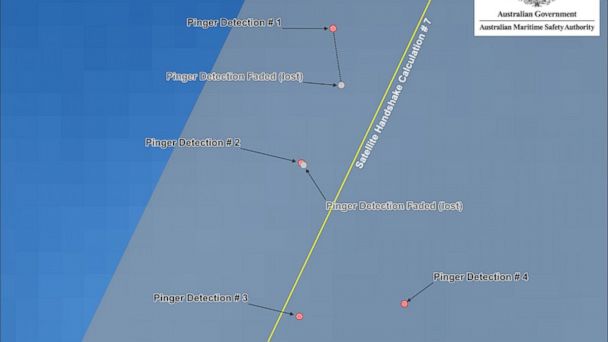U.S. Navy Captain 'Shocked' To Hear Pinger Signals
ABC's Clayton Sandell & Bartley Price report:
U.S. Navy Captain Mark Matthews is an engineer by training, not prone to outbursts of emotion. And while he's still cautious, today he's feeling a bit like he just won the lottery.
"It's a million-to-one shot based on the calculations that were done. We've been very lucky," he says.
Matthews is talking about the latest signals picked up in the middle of the Indian Ocean by the U.S. Navy's TPM-25, the stingray-shaped device being towed behind the Royal Australian Navy ship Ocean Shield as part of the search for Malaysia 370.
Matthews is in charge of the TPM-25 program and is overseeing its deployment from Perth, Australia.
The signals the TPM-25 detected are consistent with emergency "pinger" beacons attached to aircraft cockpit voice and flight data recorders, officials have said.
"I was shocked upon hearing that we'd actually had beacon transmissions, or what could have been beacon transmissions back on Saturday and then again yesterday," Matthews tells ABC News.
The TPL-25 has picked up the signals four times. The first two were heard on Saturday April 5th, the second two on Tuesday afternoon and evening, according to Australia's Joint Agency Coordination Center, which is leading the search. The first of the new signals lasted about five and a half minutes, the second lasted about seven minutes, officials said.
The area is in the same region where authorities believe the Boeing 777 went into the water after a final electronic "handshake" communication with an orbiting satellite.

(Australian Government)
In the month since the plane vanished with 239 people on board, the size of the Indian Ocean search area was so daunting that officials compared it to looking for a needle in a haystack, but not having any idea where the haystack was.
Now, Matthews says that is changing.
"I'd say we're getting more confident that we've found the haystack. But I'm going to reserve judgment until I can reliably pick up that acoustic beacon in roughly the same geographic location and I can really narrow that area down to do a sonar search with that autonomous underwater vehicle," he said.
That vehicle, a yellow, torpedo-shaped device called the Bluefin-21, is loaded with sensors including sonar that can map the ocean floor, in theory spotting airplane wreckage sitting in extremely deep ocean waters. But with a top speed of about five miles an hour, Matthews says completing a sweep of the search area could take a very long time.
"If you drew a circle around all those detections and said 'this are area is what we're going to go search', that's still weeks to months. It's probably a month and a half to two months of effort," he said.
Matthews says he has repeatedly quizzed his team, asking them what those four signals could be if they aren't coming from a pinger beacon.
"It's certainly not something that occurs in nature. I have no idea what else it would be other than an underwater beacon," Matthews tells ABC News. "I have no explanation for what else it could be. This is clearly a manmade signal."
Time, Matthews says, continues to be a challenge.
"Time is of the essence before those batteries die and the beacons stop transmitting," he said.
Up to 15 aircraft and 14 ships were expected to participate in Wednesday's search effort, officials said.

(Australian Defense Force, Lt. Kelly Lunt/AP Photo)